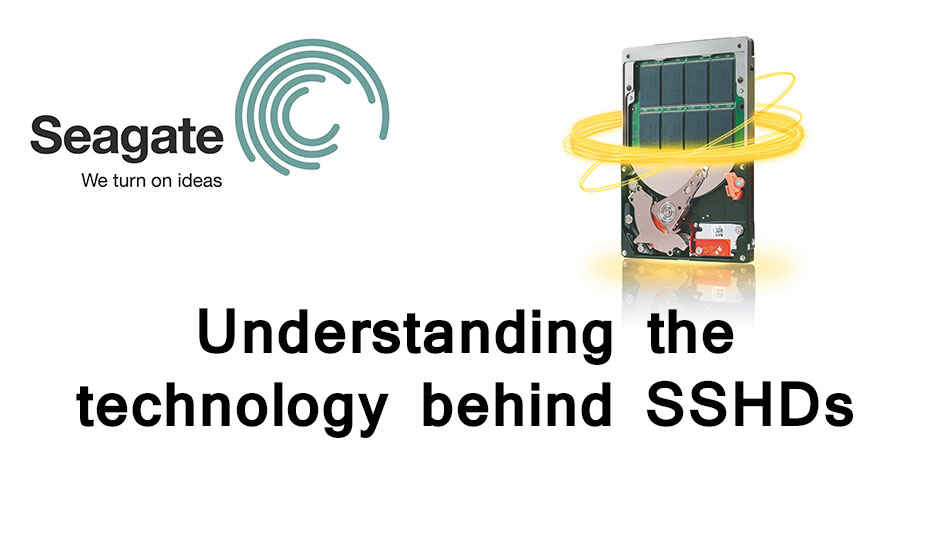Understanding the technology behind SSHDs

Promotional Feature: You've been hearing about SSHDs for quite some time. It's new and it's better than standard hard drives. So if you still have any qualms about this new technology then read on
Storage is something we can never have enough of. There is so much data that is available online and the fact that we contribute to the same with a plethora of multimedia devices which are at our disposal makes for even more data that needs to be put somewhere. This is where the need for more storage arises. However, it’s not just about adding a new hard drive these days. A few years back content quality and size was lesser than what we have now. Back then images were limited to 3-4 megapixels and video was of lower resolution. Now we’ve just gone over the cliff and entered the era of 4K resolution. Even images are generated in DSLRs that boast of double digit megapixel resolution. So the time taken to transfer, let’s say, 100 images taken at 2 megapixel resolution (3 MB each) and a 100 images taken at 12 megapixel resolution (18 MB each) is vastly different. The first situation generates 300 MBs of images while the second scenario generates 1.8 TBs of data.
While transfer mediums have improved over the ages since we had USB 2.0 earlier and now we have USB 3.0 but at the end of the line we still have a hard drive. So that’s where the “bottleneck” happens. Well, not anymore because now we have SSDs at our disposal which use arrays of NAND flash memory to store data. So while a considerable bump in storage speed has been achieved, we still can’t see SSDs to have achieved an affordable price point. There are exceptions and you can get an SSD which would give a moderate speed increment but this increment degrades over a period of time. So a slightly expensive SKU is preferred by power users to maintain a good transfer speed over a longer period of time. But these power users will still have conventional hard drives for storing the bulk of their personal data.
|
|
|
|
|
|
HDD |
SSD |
|
Mechanism |
Magnetic platters |
NAND memory |
|
Average density |
80GB |
64GB |
|
Performance (Read) |
100 MB/s |
400 MB/s |
|
Performance (Write) |
75 MB/s |
400 MB/s |
|
Power |
4W |
1W |
|
Shock threshold(operational) |
0.5G |
20G |
|
Shock threshold(idle) |
170G |
1500G |
|
Temperature |
5 – 60 degrees |
0 -70 degrees |
|
Noise |
0.3 dB |
0 dB |
|
MTBF |
Approx. 0.7 million hours |
Approx. 2 million hours |
Now we have technology that uses an SSD to cache data that it to be moved between the hard drive and peripherals. However, this entails the use of separate drivers and since the two devices are separate there is a slight time differential that comes into play. So the folks over at Seagate have come up with the SSHD (Solid State Hybrid Drive). Think of it as a hybrid between HDDs and SSDs with the best of both worlds. It has greater capacity and faster speed while the cost isn’t astronomical on a per GB basis. What’s different here is that the two things are packaged together such that there is no need for any extra hardware or drivers, all you need is one SSHD and connect it to your SATA port like you would for any other hard drive.
The SSHD looks exactly like normal hard drives. It even comes in the same thickness so you don’t have to worry about moving your existing hard drives around or getting a new adaptor bracket. However, for laptops one needs to take care as the current models are 7 mm thick and the higher capacity one is 9 mm thick. This may be a inconvenience for thin laptops are they feature 5 mm hard drives and can squeeze in a 7 mm hard drive at best.
|
What about compatibility?
After reading through all this you might wonder whether this will work in your machine and yes that is a legitimate query. If you are using a computer that still has SATA II ports then, Yes. Like we’ve mentioned before the SSHD is an example of a seamless integration of two technologies – the HDD and the SSD. There is no need for any extra hardware or drivers to use a SSHD. So you don’t have to worry about getting the drivers beforehand in case you want to install your OS onto the SSHD as is the case with RAID setups. On the bright side these drives are compatible in all operating systems be it a Mac or a Windows machine. Linux is supported as usual.
These drives have already found use in the industry with some OEMs using the SSHD in their devices. Prominent amongst these would be that Dell offers SSHDs in lieu of HDDs and the much talked about Steam Machine prototypes have also been seen with a 1 TB Seagate SSHD in them.
This was the first in a series of articles revolving around SSHDs. Check out the other articles here(link).




